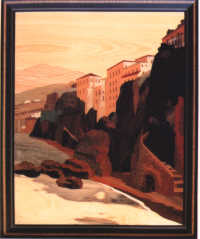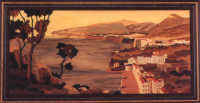|
Sorrento
Beaches
Marquety
Personages
Typical
Dishes Typical
Products Place
to Visit
|
Origin
The
Sorrentine peninsula boasts a secular tradition in the art of
marquetry. From the first half of 800, talented Sorrentine artisans
were the first to acquire such technique, which spread extensively all
over the Neapolitan territory.
Thanks
to the fame which Sorrento enjoyed as a holiday resort, many important
people from the world of politics and international culture fame, had
the opportunity to appreciate the skill of our master cabinet-makers,
enough to be engaged by Francesco I of Bourbon for the restoration of
furniture in the Royal Palace
|

*Harmony
between design and quality
wood
|
|
The
technique
It
is based on assembling together small pieces of wood, first sawed to
the shape of the design required to be produced. At first, in order to
obtain the shades, all the natural wood essences were applied (walnut,
holly, thuja, orange tree, etc.) while the frame work of the furniture
was olive tree, walnut or chestnut.In this way you acquired a mixture
of light and dark due to the various tonalities of the wood and
finally perfecting it with small engravings, always hand-made, filled
with dark plaster.
|
|

*View of Sorrento realized with different types
of wood
|
Modification
of the Sorrentine marquetry.
With
the passing of time, the traditional technique of the Sorrentine
marquetry was replaced by the "ricacciatura", that is a
method typical of the French marquetry, which uses India ink to
underline the drawings. However, this technique turned out to be
precarious because of the fading in time of the black outline. Other
procedures, which modified the old technique in the second half of
800, was the use of coloured wood. In this way one was able to satisfy
less demanding purchasers.
|
|
The
downfall was reached with the realisation of "enamel on wood",
where the inlay is limited only to the outline of the design, and the
rest is obtained simply by painting with water colours the motif
desired.
Latest
techniques
Are
those of the drilled ingot, carried out with a hack-saw, and those of
mosaic on wood, reproducing the
Opus Tesselatum of Roman tradition, achieved by arranging the
various woods in vertical sense, which having been previously placed
in geometric or flowered motifs were then cut into strips and laid on
the frame structure of the furniture.
At
first the marquetry was closely tied to decorations reproducing
Pompeian and pagan motifs. Later the craftsmen began to represent
scenes of daily life, and the Neapolitan costume depicts the upsurge
of Sorrentine marquetry.
Marquetry
today
The
Sorrentine marquetry is today still carried out by master craftsmen
who have refined their techniques but still without relinquishing the
tradition handed down by their ancestors.
|
|
